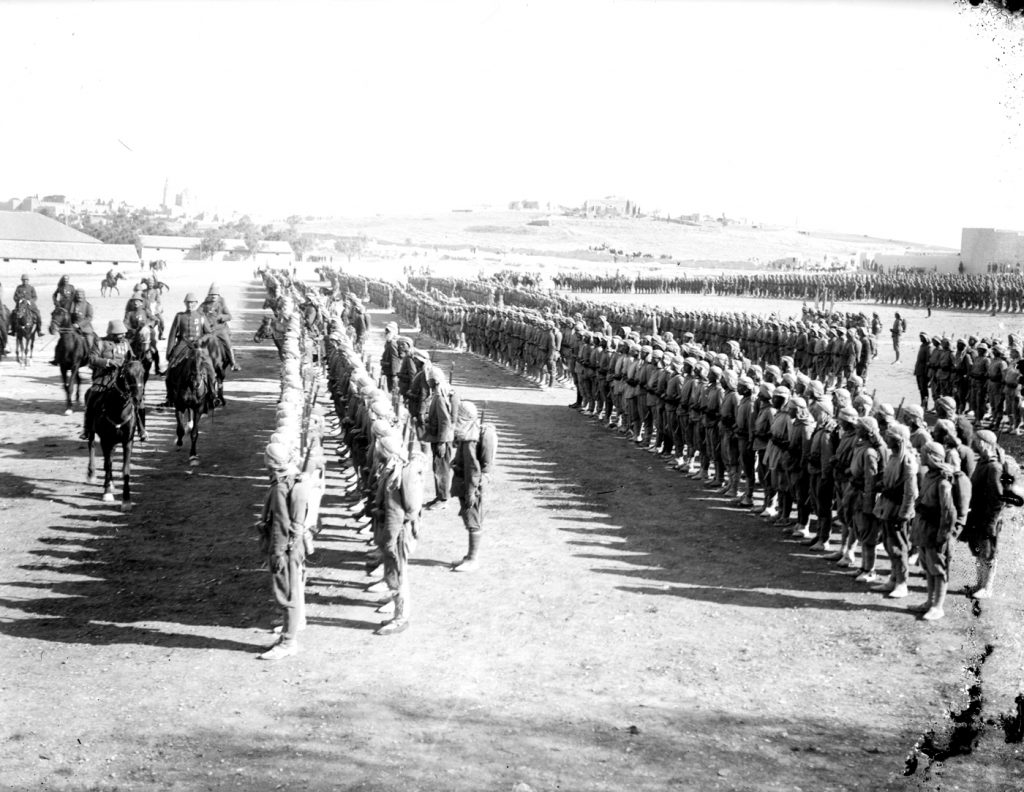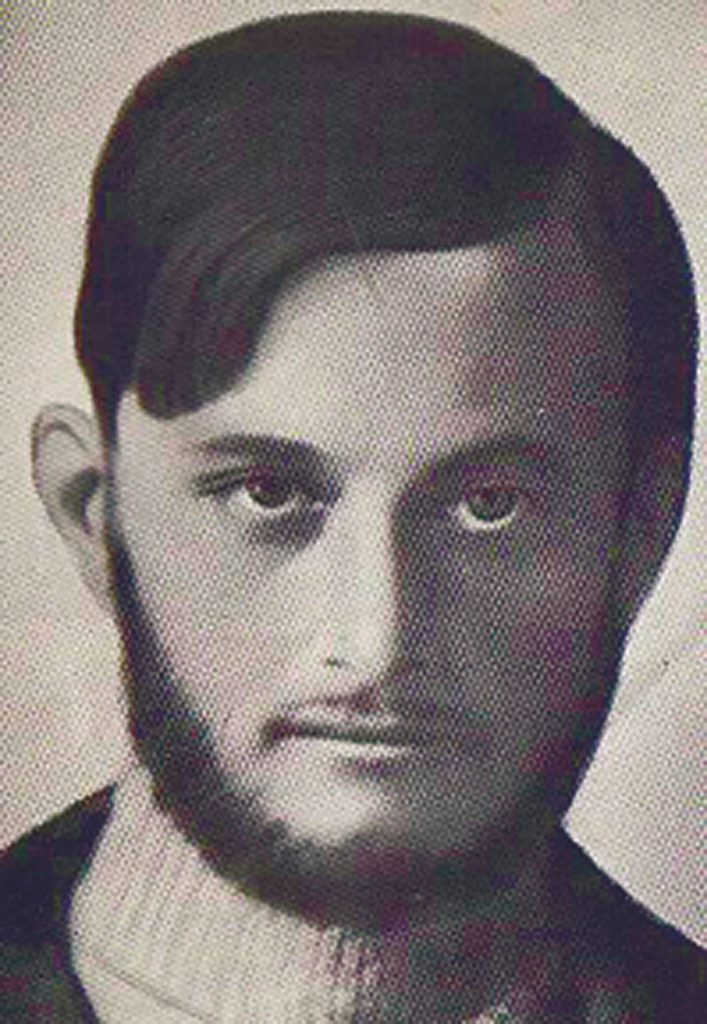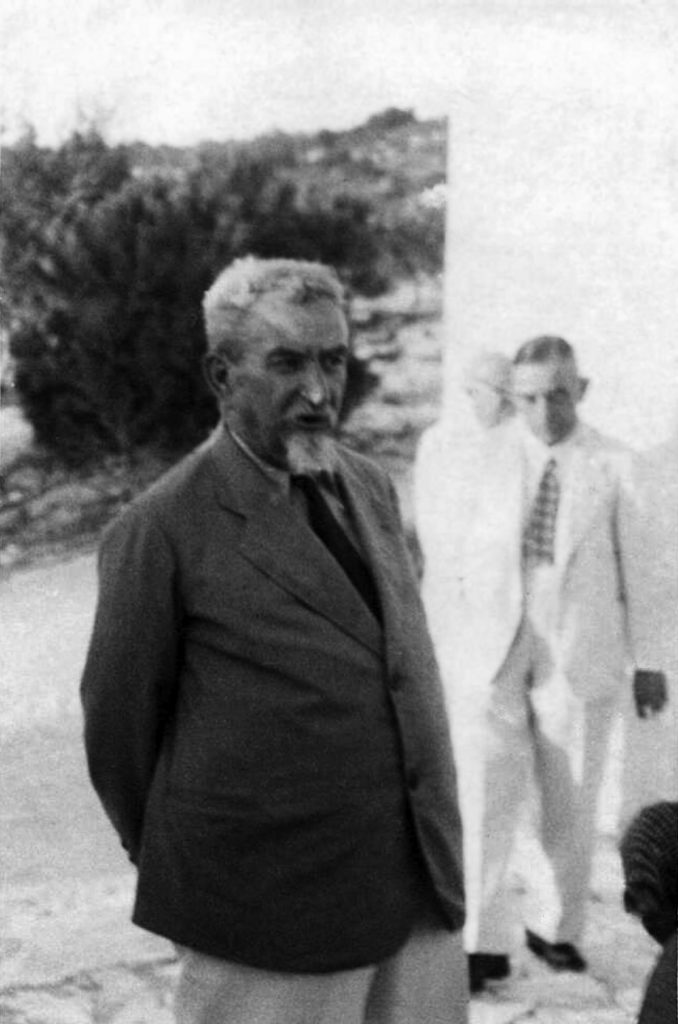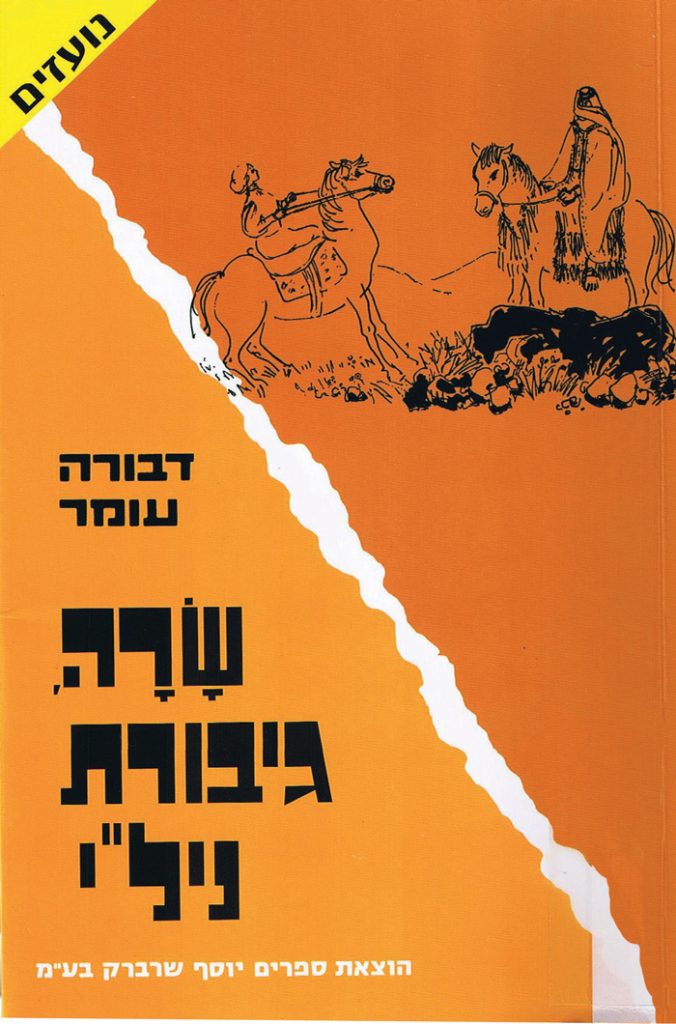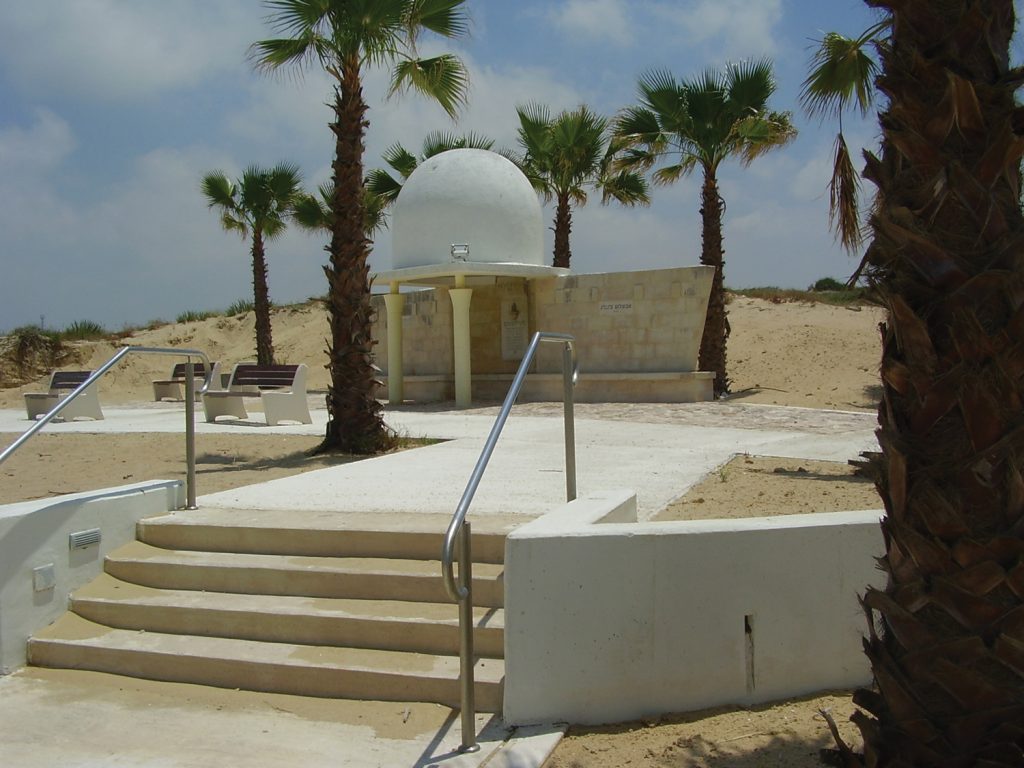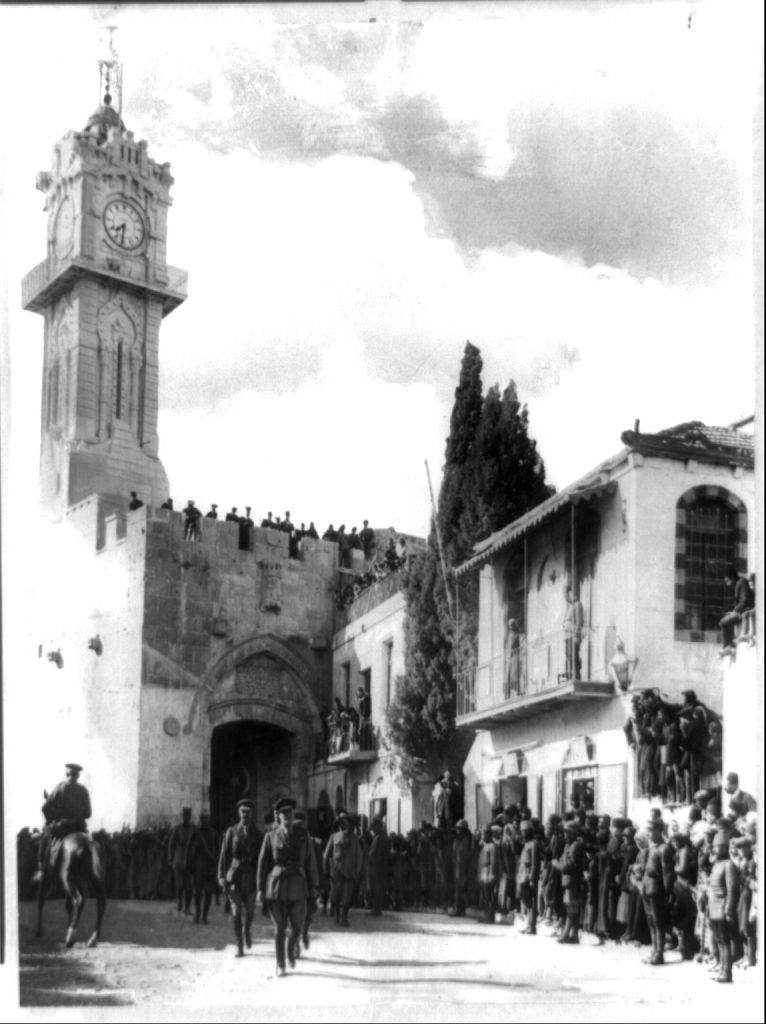It’s Complicated
One of the most famous and heroic Jewish contributions to World War I is that of Nili (a Hebrew acronym meaning “Israel’s Glory Does Not Lie”), the spy ring that informed the British of Turkish military movements in the Middle East during the buildup to General Edmund Allenby’s conquest of the Holy Land, Syria, and Transjordan. Most members of Nili were captured and killed by the Ottoman administration, with the exception of leader Aaron Aaronsohn, who spent much of the war in Egypt, liasing with the British. Aaronsohn’s detailed knowledge of water sources in the Negev aided British well-digging efforts along the desert route from Rafah to Beersheba, which Allenby later used to surprise the Turkish garrison there, opening the gates of the Holy Land to the Allies.
Two-way track. Via the HMS Monegam, Nili smuggled charity into starving Palestine and relayed information to the British. The spy ship in dock
Nili’s huge gamble more than paid off, but fellow Zionists focused instead on how these self-organized amateurs had endangered the entire Jewish population of Ottoman Syria and Palestine (the British, it must be admitted, showed more gratitude):
Last year a spy ring was uncovered in Zikhron Ya’akov and the experimental agriculture station, culminating in a huge trial. The bloodstains have yet to be wiped away, and the tears still haven’t dried. Yet now, the first official representative of the British authorities in Zikhron is one of those very spies [Alexander Aaronsohn]. The only house in Zikhron to be visited by the Zionist Council is the one where the spy plot was hatched…. I protest this conduct, and I wish to point out that the homeland of our dreams should be founded on moral conduct and fair methods. The spies were paid well enough for their actions. We must not allow them this honor. Thousands will follow in their footsteps, blinded by their success. (Eliezer Livneh, Yosef Nedava, and Yoram Efrati, eds., Nili: A History of Political Daring [1981], p. 372 [Hebrew])
Today it seems absurd that Nili was pilloried just when its ringleaders’ decision to support the British against the Turks had been so thoroughly vindicated. But the above letter, addressed to the Zikhron Ya’akov village council by local doctor Hillel Joffe in the autumn of 1918 – just two days after the British had conquered Zikhron from the Turks – was mild compared to some of his other utterances on the subject:
Woe to those cold-blooded murderers, those heartless patricides who endangered their village and the whole Yishuv [the Jewish population of Ottoman Palestine] for the sake of their own ambitions! (Hillel Joffe’s Memoirs, Letters and Diary [The Zionist Library, 1985], p. 387 [Hebrew])
Dr. Joffe feared that the masses, blinded by Nili’s success, would follow in its footsteps. But this concern proved baseless. Nili and its operations were sidelined by the Israeli establishment and excluded from the national commemorative consciousness for decades. Only in 1967 – fifty years after the Turks had rounded up Nili’s activists and after deep-seated political, cultural, and social changes in Israel – did the first state commemoration take place in Zikhron Ya’akov. In the early 1930s, Nili’s supporters held their first memorial for Sarah Aaronsohn, Aaron’s sister, who ran the spy ring in his absence. One of the assembled voiced their frustrations:
Malevolence, malice and envy were behind the community’s total lack of appreciation for Sarah and her heroic friends. (Billie Melman, “The Legend of Sarah: Gender, Memory and National Identities [Eretz Yisrael/Israel, 1917–90],” p. 64)
A commemorative pamphlet issued at the time by the Bnei Binyamin Young Farmers’ Federation lamented the exclusion of Nili’s “bourgeois” homesteaders (idealized in the biblical character of Boaz, from the book of Ruth) by the overwhelmingly socialist Labor Zionists, who controlled the political consensus:
Sarah Aaronsohn is a national heroine unrivaled in the annals of the Hebrew revival. … Aaronsohn is not only the greatest national heroine in this period of our revival, she is also our own heroine, the heroine of the class modelled on Boaz, those who believe that the collective is built through the efforts of the individual and as his responsibility; whose values are constantly derided as un-idealistic and devoid of any iota of self-sacrifice; Sarah is not a solitary heroine in our ranks, she represented an entire organization of civilian farmers, who gave their all, devoting all their physical and mental energies to the liberation of our homeland and providing much needed aid to the Yishuv in its most difficult moments. (ibid., p. 62)
With one commander responsible for massacring Armenians all over the Ottoman Empire and the other accused of murdering innocent civilians while conquering Belgian villages, Palestine’s Turkish-German command hardly reassured Jews. Djemal Pasha, Ottoman ruler of Palestine, reviews troops with German general Kress von Kressenstein during World War I
In the Eye of the Storm
Nili’s espionage was controversial from the outset. The fledgling Yishuv faced a conflict of interests from the moment Turkey plunged into World War I alongside Germany and Austria-Hungary in the autumn of 1914, three months into the war.
Fighting locusts for the Ottomans by day and undermining their rule by night. Aaron Aaronsohn
Conditions in Palestine deteriorated. Imports were cut off, and the Haluka – the funds from abroad on which the ultra-Orthodox majority of the Yishuv subsisted – dried up as European sovereigns forbade financial transfers to enemy territory, exacerbating the severe poverty and hunger there. Cholera and malaria spread, contracted from the soldiers conscripted from all over the Ottoman Empire. And the most severe locust plague in living memory struck in March 1915, devastating anything edible until October.
The Turkish government imposed draconian tax measures to finance its military mobilization, cracking down on all non-Muslim populations, especially those seen as a threat. The systematic genocide of over a million Armenians throughout the empire began in April 1915, and the Jews feared they were next in line.
The first to persuade the British military command to exploit Nili’s spy capabilities. Absalom Feinberg
Bilateral “capitulations” – under which foreign nationals lived within the Ottoman Empire under the protection of their own governments, exempt from taxation and prosecution – were abolished. Citizens of enemy countries, including most newcomers to the Yishuv (mainly from Russia), had to choose either deportation or Ottoman nationalization – and conscription if of age. Large swathes of property were expropriated for military purposes. Among the thousands conscripted for forced labor in the Turkish army, many died of infectious disease within their appallingly unsanitary environment.
Prominent Yishuv leaders such as Arthur Ruppin, David Ben-Gurion, and Yitzhak Ben-Zvi were expelled from Palestine, finding refuge in British-controlled Egypt. Holding weapons, even for self-defense, was a crime, and even the most innocent displays of Jewish nationalism (such as the use of Jewish National Fund stamps or Hebrew signs in Tel Aviv) were outlawed.
Finally, in the spring of 1917, the Jewish residents of Tel Aviv–Jaffa were driven from their homes. By the end of World War I, twenty thousand Jews – almost a third of Palestine’s Jewish population – had died, mainly of sickness and starvation.
The leaders of the World Zionist Organization faced a dilemma. The outcome of the war was uncertain. The Ottoman Empire had long been in decline, but its alliance with a strong Germany meant that the Turks could end the war on the winning side – and eager for revenge against the pro-British Jews of Palestine. On the other hand, if the British advanced from Egypt to conquer Palestine, the dire plight of the Yishuv would improve.
So the Zionist leadership refused to openly support either side. But several important figures gambled on a British victory, convinced that a British takeover of Palestine would pave the way to a Jewish national home. These visionaries included Chaim Weizmann, who had diplomatic contacts with the British; Joseph Trumpeldor and Vladimir (Ze’ev) Jabotinsky, who founded the Jewish Legion; and the group behind Nili, the second-generation pioneers from the first wave of Jewish immigration, living mostly in the farming villages on the coast.
The idea of a pro-British espionage network was conceived by Absalom Feinberg of Hadera and his friends Aaron Aaronsohn (a world-famous agronomist known for his discovery of wild emmer wheat) and his younger brother Alexander, both of Zikhron Ya’akov. Feinberg originally intended to help the British by carrying out actual military missions, but the difficulties involved convinced him to be content with passing information about Turkish military positions to the British army.
Betraying the Turks did not come naturally: all three activists had been involved in the Gideonites, a short-lived semi-military movement that had called on Jews to prove their loyalty and fight for their land by enlisting in the Turkish army. Aaron Aaronsohn had even been engaged by Palestine’s Turkish ruler, Djemal Pasha, to help supervise the eradication of the locust plague in Palestine and Syria. Aaron, the oldest of the three, was clearly torn. As he wrote to a friend:
You can imagine that I was in tremendous turmoil and had many sleepless nights. And even after deciding which path to take, I endured endless deliberations about how to achieve the goal. (Livneh, Nedava, and Efrati, p. 68)
The Turkish army’s humiliation of the Gideonite recruits had turned the tide, and their reservations increased as the Turks stepped up their policies against the Yishuv. Returning from Istanbul to Palestine after the failure of her marriage, Sarah Aaronsohn witnessed the ongoing Turkish massacre of Armenians, which only added to her comrades’ fears. The Ottoman confiscation of Jewish weapons seemed to be the first step in rendering Jews defenseless when the time came for deportation or worse. But for Aaronsohn, perhaps the Turks’ greatest crime was their alliance with the Germans. Germany was then considered one of the most enlightened and tolerant nations. Yet Aaronsohn wrote to his friend Judge Julian Mack in Chicago in 1916:
I am anti-German beyond a shadow of a doubt, more now than ever. In fact, this German war completely confirms my predictions. … Did I not long ago foresee the depths that would be reached by the German poison? Did I not warn in private conversations and public lectures against the German danger, though it wasn’t easy to voice such feelings without raising suspicions of being a provocateur? (ibid., p. 58)
More Than Just Spies
Known to the British as “Organization A,” Nili numbered thirty-odd hard-core members – all relatives or close friends of the Aaronsohn family – plus a few dozen affiliates. Aaron Aaronsohn spearheaded the group, but when he left to coordinate with the British in Egypt and England in the summer of 1916, Feinberg ran the operation in Palestine. He in turn was replaced by Sarah Aaronsohn and Joseph Lishansky after disappearing en route to Egypt to reestablish communication with the British. Feinberg’s body was discovered only in 1967, hastily buried where he had been attacked by Bedouin not far from Rafah.
Generations grew up on Devora Omer’s Sarah Aaronsohn: Heroine (1967), eventually creating a grassroots consensus that the protagonist and her fellow spies should be honored as war heroes
The details of Nili’s espionage are generally well-known. Aaron Aaronsohn’s government work combating the locust infestation served as his cover, as did his experimental agricultural station (investigating the use of ancient plants in modern farming) in Atlith, south of Haifa. From the summer of 1915, attempts were made to contact British military intelligence and relay information painstakingly amassed at great personal risk. Only in 1917 was a regular method of liaison established: the British ship Monegam – nicknamed “Menachem” by Nili’s members – anchored periodically off the coast of Atlith, and packages were transferred to and from by boat at night.
After only a few months of such operations, Nili was discovered. In September 1917, the Turks intercepted a carrier pigeon bearing an encrypted message. Though they couldn’t crack the code, the pigeon confirmed Turkish suspicions of an active espionage ring in Palestine. Not long afterward, Nili agent Na’aman Belkind was captured on his way to Egypt to find Feinberg (his cousin). Belkind was interrogated under torture, and the papers found on his person led to the roundup of the organization’s other members. Most were tortured as well. To protect her comrades, Sarah Aaronsohn committed suicide, and Reuben Schwartz was found hanged in his prison cell, though his captors may have staged this scene. Lishansky and Belkind were publicly hanged in Damascus in December 1917; many others were charged and imprisoned.
Espionage was not Nili’s only priority. For instance, the organization alerted the world to the expulsion of the Jews from Tel Aviv–Jaffa in April 1917 as well as other key developments in Palestine. As a result, local Turkish ruler Djemal Pasha was forced to improve his treatment of refugees and reconsider further expulsions, such as that of the entire community of Jerusalem.
The Monegam was also used for bringing sorely needed funds into Palestine. Money collected by Aaron Aaronsohn in Egypt was smuggled into Palestine onboard the vessel, providing a lifeline for numerous Jews.
In addition, Aaronsohn helped other Yishuv leaders establish the Jewish Legion, which assisted the British in the final stages of their conquest of Palestine. And he was active in Chaim Weizmann’s diplomatic efforts in the British Foreign Office, culminating in the Balfour Declaration.
Were Nili’s espionage operations worth the risk? Although the organization passed on useful information to the British, they would probably have defeated the inferior Turkish forces anyway. Nili’s intelligence saved English soldiers, but did it justify jeopardizing the entire Yishuv? On the other hand, Nili’s work – and Aaronsohn’s diplomacy – led to warm relations between Britain and the Yishuv leaders just prior to and in the early years of the British Mandate, resulting (albeit by a very tortuous route) in a Jewish national home.
Natives or Newcomers?
Though history may have vindicated Nili’s members, many of their contemporaries disapproved. As details of Nili operations emerged, attempts were made to stop them. In the summer of 1917, the Zikhron Ya’akov residents’ committee demanded that Sarah Aaronsohn refrain from further contact with the British, and Lishansky was barred from the village. Zikhron residents worried that if the organization’s activities were uncovered, the Turkish authorities would collectively punish the Jews of Palestine, just as they had the Armenians. Such concerns were not unfounded; in September 1917, shortly before her arrest, Sarah wrote to Aaron:
If people don’t want to take risks, can we force them to? They are perfectly justified in demanding, “Who is asking you to do this?” And if, God forbid, with all our care, we should fail, then not just a few of our leaders or twenty members of Nili will be hanged. All the Yishuv will be called to trial, and the judgment will be expulsion or hanging or massacres. (Anita Engle, The Nili Spies [London, 1959], p. 179)
The argument was not only about responsibility toward the Yishuv; two thousand years of exile and political dependence had ingrained loyalty to the authorities. Spying for the “enemy” was considered immoral and treacherous. Nili activists were accused of profiteering, despite the guidelines laid down by Feinberg from the outset of negotiations with the British:
Do you really think I would agree to do this for money? We are offering the British a partnership, with the redemption of our people as our only reward. (Livneh, Nedava, and Efrati, p. 268)
In fact, not only did Nili refuse payment from the British, even its expenses were only partially covered.
Yet opposition to Nili also reflected a deep ideological divide, in many ways a forerunner of Israel’s political left and right today. Nili’s founders were native-born, Hebrew-speaking children of the First Aliya pioneers, landowning farmers who believed in economic freedom and private enterprise. This civic elite was swiftly being edged out by the recently arrived Second Aliya, whose socialist ideologues dominated the Zionist corridors of power. The newcomers denounced the veterans as bourgeois opportunists who exploited cheap Arab labor and ignored national needs. The Zikhron farmers’ attempts at quasi-political organization through the Gideonites had failed, and now their decision to establish a politically oriented spy ring was anathema to the nascent Labor movement.
There was plenty of personal enmity too. Zikhron resident Dr. Hillel Joffe resented Aaron Aaronsohn for appointing Ze’ev Brinn rather than himself to head the Public Health Institute and direct the fight against malaria in 1912. Joffe also accused Aaronsohn of plagiarizing his own research. Altogether, Zionist activists feared Aaronsohn’s growing international reputation and influence. As one of them warned:
Apparently, Aaron Aaronsohn intends to develop the special committee [for the collection of donations to the Holy Land] into a political entity to replace or take over the Zionist Organization. (ibid., p. 190)
Nonetheless, Yishuv leaders occasionally cooperated with Nili to serve their own ends. Meir Dizengoff, the first mayor of Tel Aviv, accepted and distributed money brought into Palestine by Nili. Only when the spy ring was on the brink of exposure did he cover his tracks, transferring funds to the Marxist-Zionist Po’alei Zion movement for safekeeping. Nili was also recruited to smuggle two Jewish delegates out of Palestine, on the Monegam, so they could appear before the U.S. Congress as it debated support for the Balfour Declaration.
Yet antagonism against Nili grew. Residents of Zikhron Ya’akov directed Turkish soldiers to Nili agents, and when Joseph Lishansky fell into the hands of the Ha-shomer militia, its membership decided to execute him and hand over his body to the Turks (see “Guard Down,” p. 51).
Final Acceptance
The non-socialist Zionist camp, with which Nili’s members identified, failed to consolidate its political power. It received a crushing blow with the death of rising star Aaron Aaronsohn in a plane crash in 1919. Furthermore, with its emphasis on individualism – as opposed to the “common good,” around which the communists and socialists of the workers’ movements rallied – this faction tended to bog down in personal and sectorial interests.
When Ze’ev Jabotinsky and his Revisionist Zionists took over in the twenties and thirties, the moderate Zionist majority turned its back on what it saw as an extremist faction, thereby strengthening the rival socialist camp, though only a minority of the Yishuv actively identified with the Labor Zionist movement.
Nili’s rehabilitation, however, began well before Israel’s right wing achieved its first political victory in 1977. The story of the spy ring’s heroic efforts gradually penetrated Israel’s public awareness, prompting spontaneous, unofficial commemorative ceremonies. This trend peaked with the 1967 publication of Devora Omer’s Sarah Aaronsohn: Heroine. Published in English as The Gideonites, this popular work transformed Nili’s image.
Another landmark in Nili historiography was the discovery of Absalom Feinberg’s remains by police detective Shlomo Ben Elkana shortly after the Six-Day War. Uncovered under a palm tree near Rafah, they proved that rumors incriminating Joseph Lishansky in Feinberg’s death had been purely malicious. In the aftermath of Israel’s military victory, attitudes changed and hatchets were buried, opening the gates of Israel’s political pantheon to right-wing heroes as well as Labor Zionists.
Yet Nili’s story raises crucial moral questions, still at the heart of Israeli discourse: Can a minority coerce the majority in matters of public policy? To what extent can a minority go its own way if the majority seems politically blind? And should political opponents be marginalized and excluded from collective memory, even when, with hindsight, their actions are vindicated?
The spy ring’s dream becomes reality. Allenby and his troops enter Jerusalem’s Old City via Jaffa Gate to accept the city’s surrender
Further reading:
Eliezer Livneh, Yosef Nedava, and Yoram Efrati, eds., Nili: A History of Political Daring (Schocken, 1981) [Hebrew]; Yosef Gorny, “Between Historic Activism and Contemporary Activism,” in The Second Aliya, ed. I. Bartal (Jerusalem, 1998), pp. 419–34 [Hebrew]; Anita Engle, The Nili Spies (London: Hogarth Press, 1959); Billie Melman, “The Legend of Sarah: Gender, Memory and National Identities (Eretz Yisrael/Israel, 1917–1990),” in Gender in Israeli Society: Women’s Time, ed. Hannah Naveh (Vallentine Mitchell, 2003).


